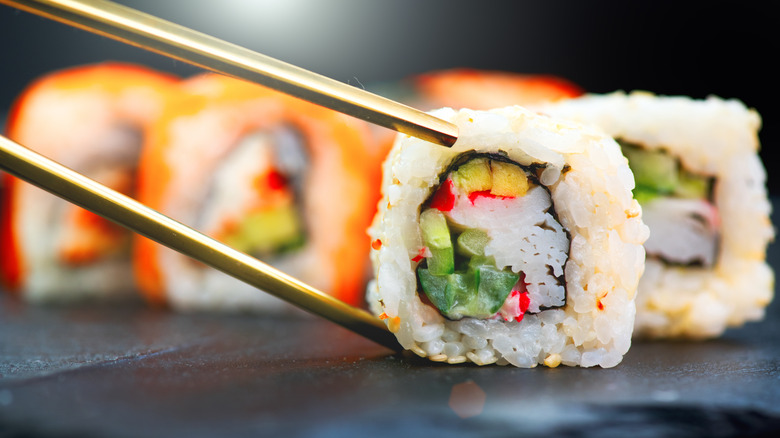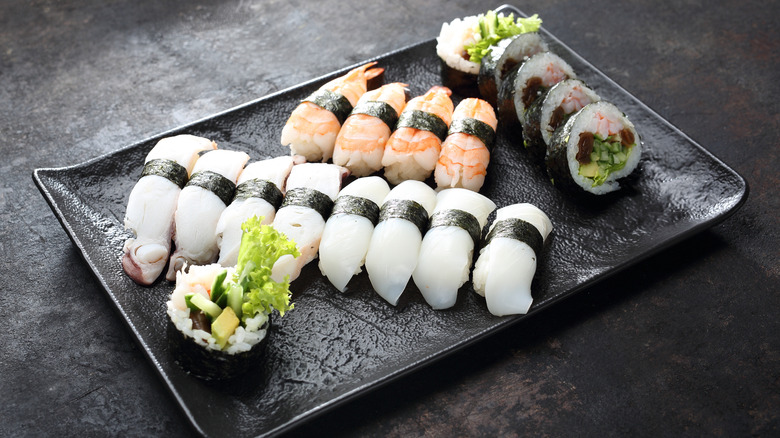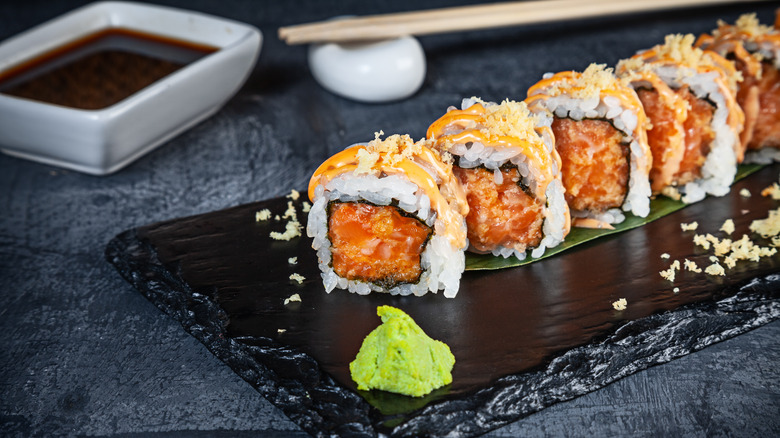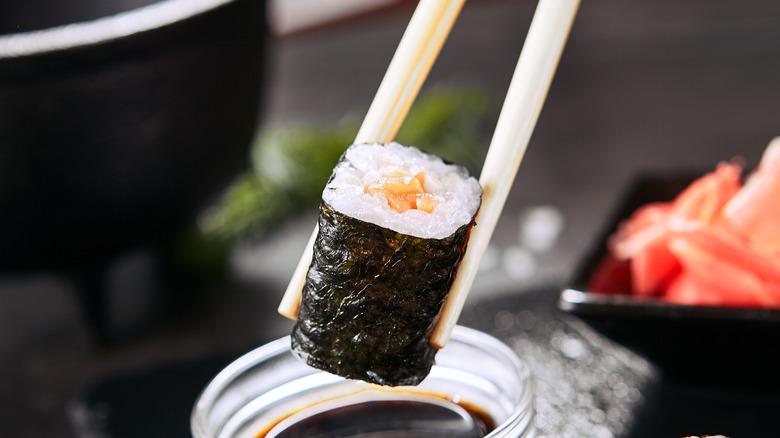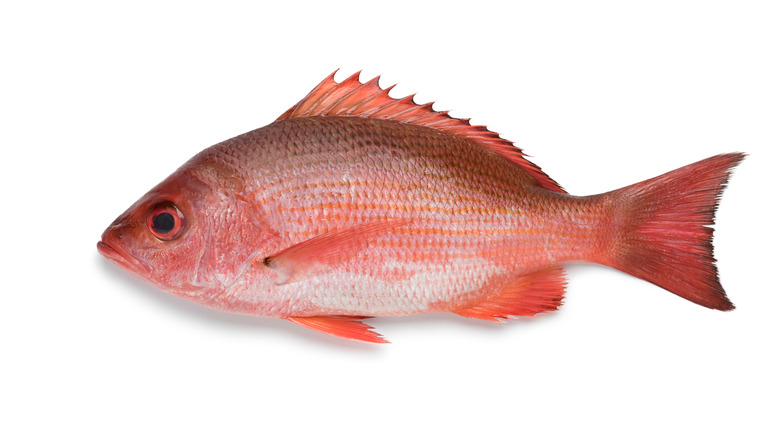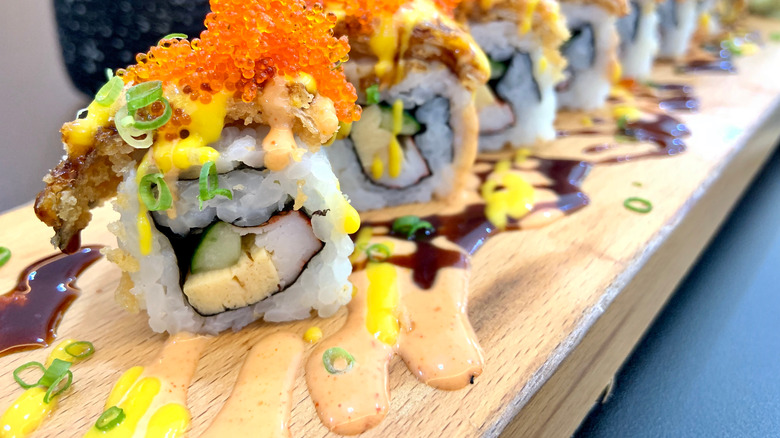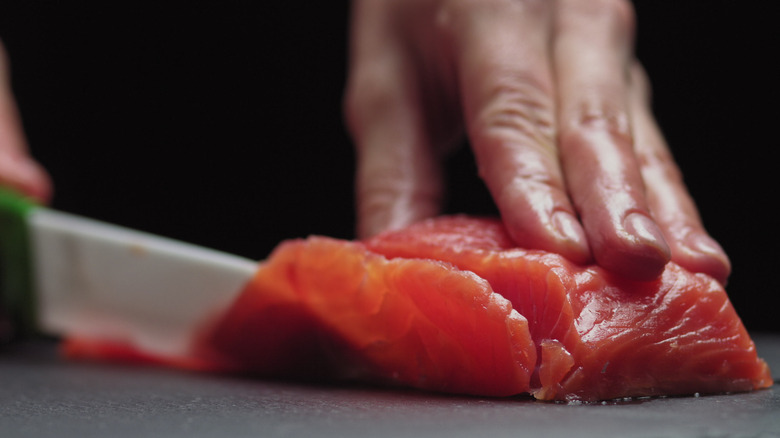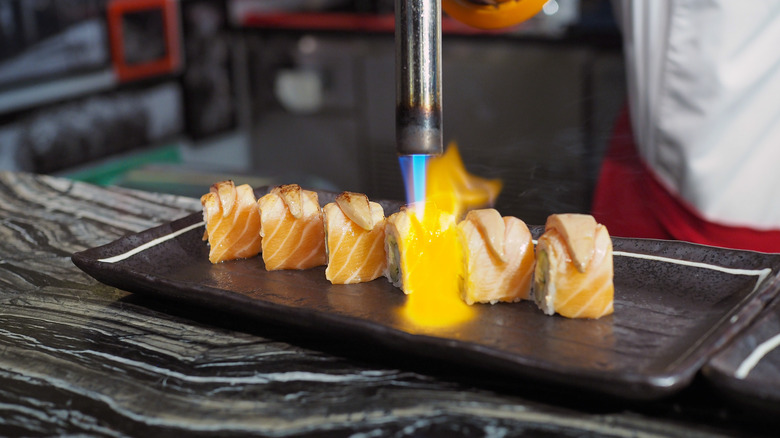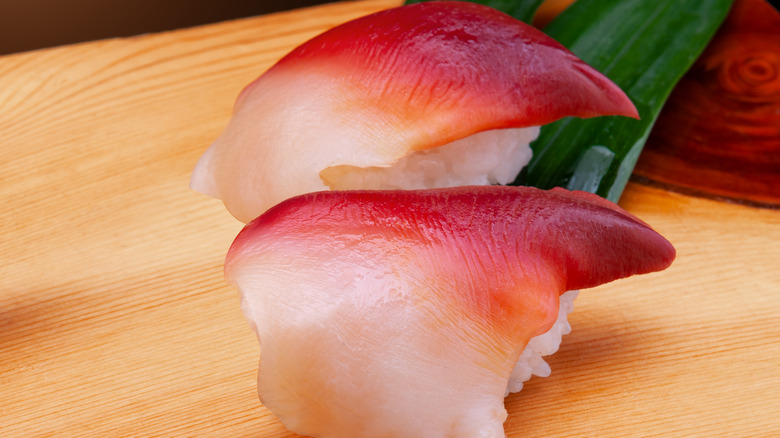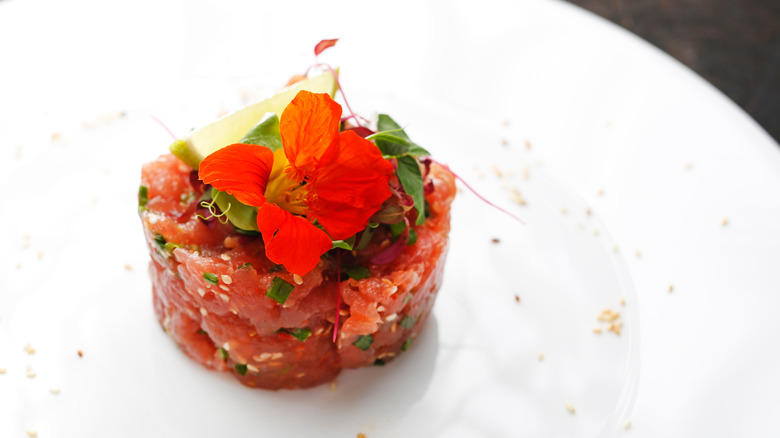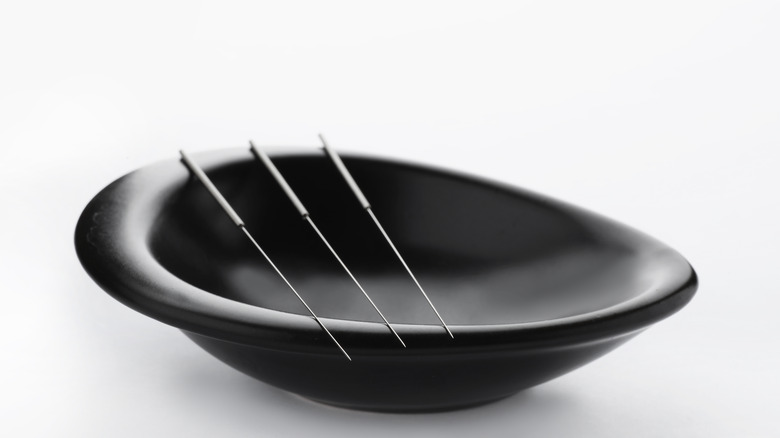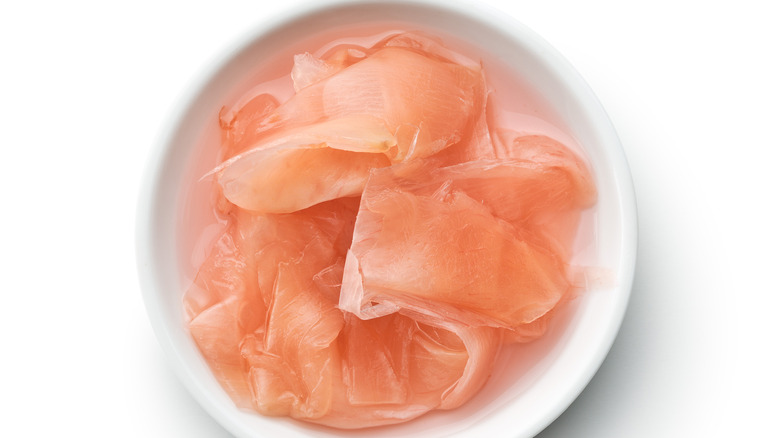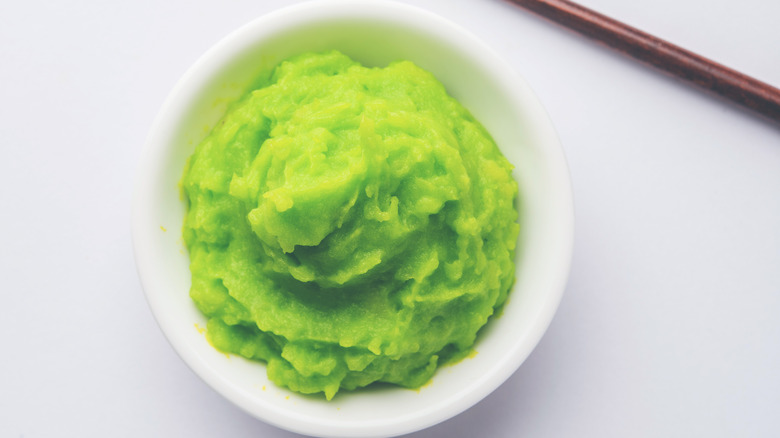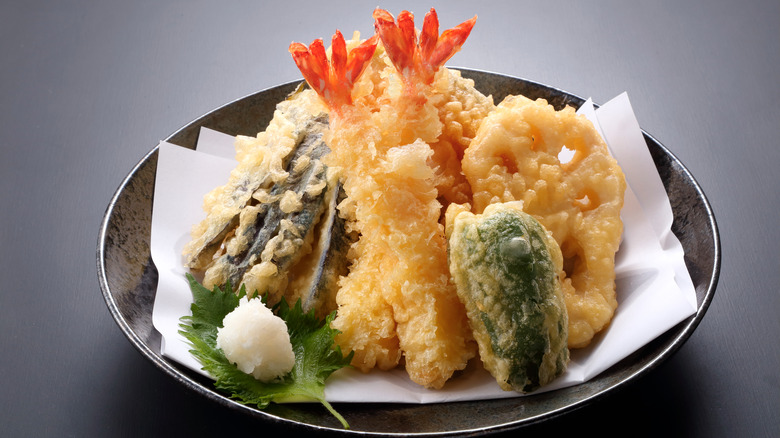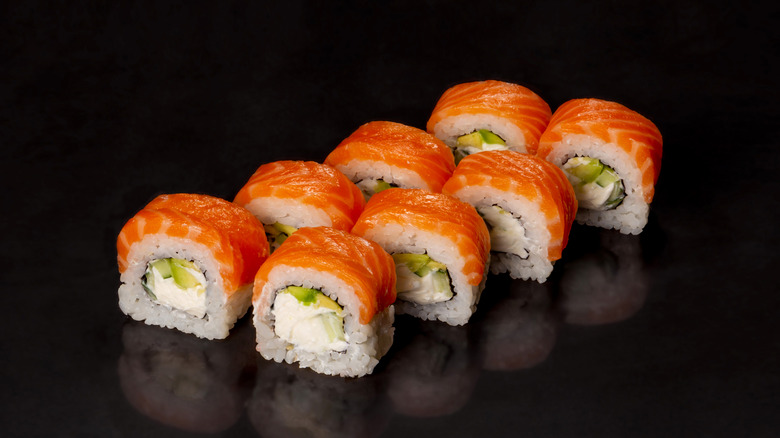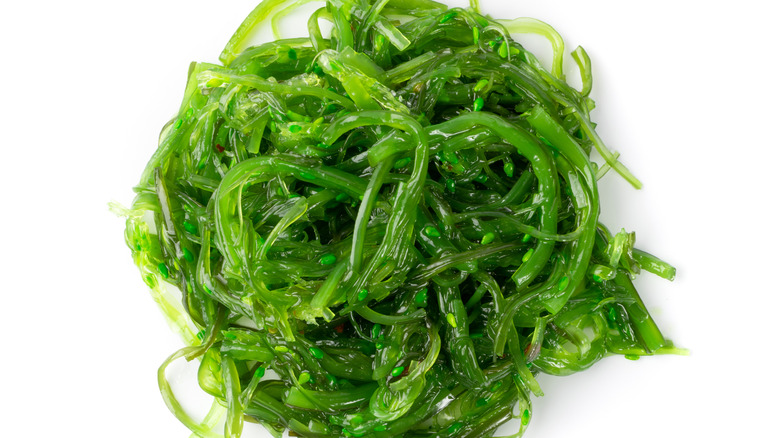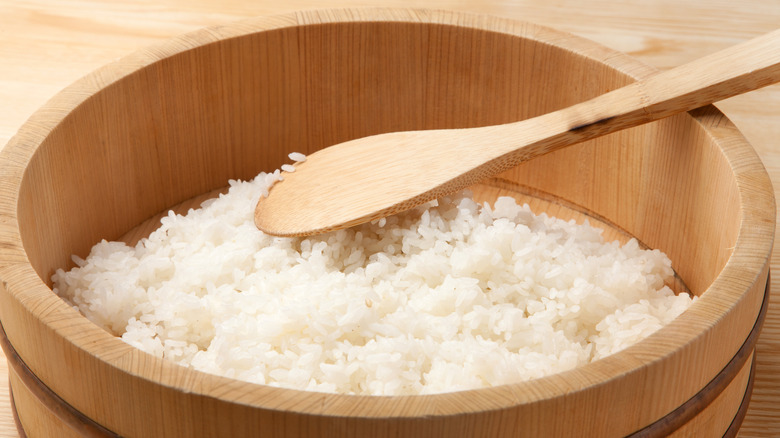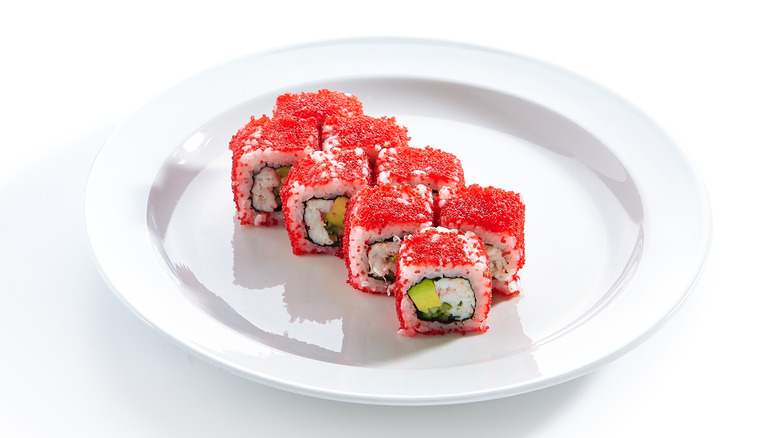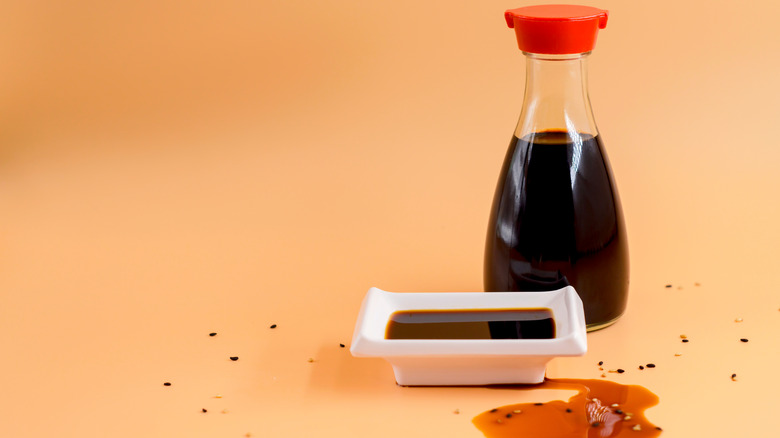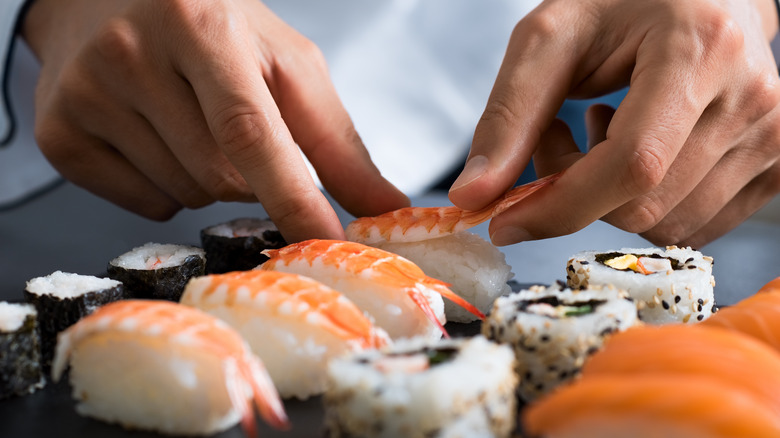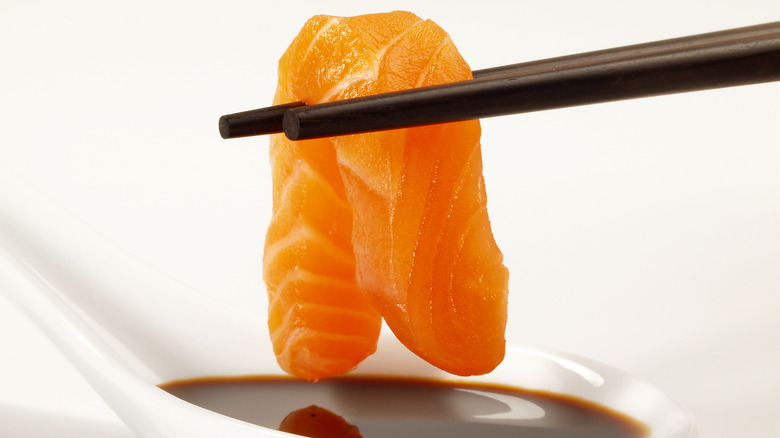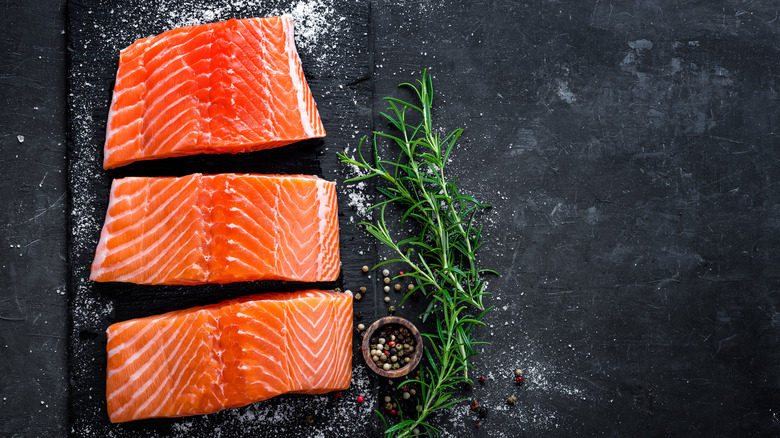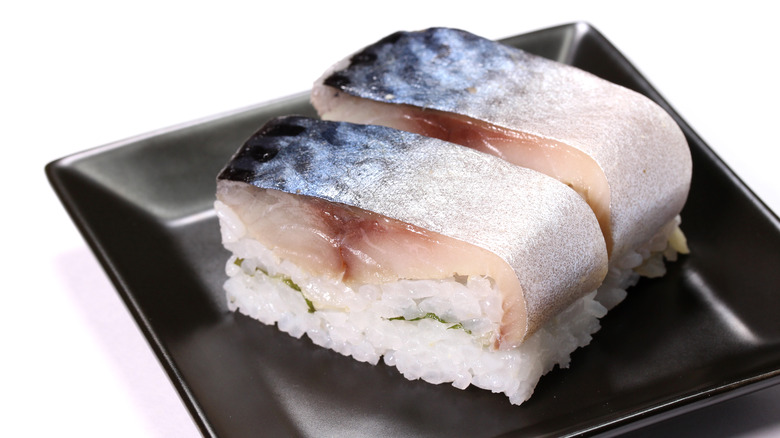Things You Should Never Order From A Sushi Restaurant
For those of us who love sushi, there's nothing like a night out at a good sushi restaurant, dining on plates or platters of perfectly shaped nigiri, carefully sliced sashimi, and crunchy, salty, sweet, and savory maki rolls. But whether you're going to your favorite spot or trying out a new place with rave reviews, you have to be careful about what you order.
From fake wasabi to mislabeled fish to spicy rolls past their prime, there are plenty of ways that your meal at a sushi restaurant might not be exactly what you hoped for or expected. It's not always the restaurant's fault, and there's more to being an awesome sushi restaurant than serving tasty seafood or sourcing acupunctured fish that probably had better health care coverage than you do. The truth is you might not know what's actually in your food, whether that's the wasabi, the ginger, the or even what's in the fish itself.
So whether you're a kamikaze roll lover, a sashimi purist, or have a soft spot for teriyaki sauces, here are the tricks to choosing what you should never order from a sushi restaurant.
Butterfish
Escolar, mistakenly known as butterfish (and often mislabled as white tuna or albacore tuna, per Food Republic), is considered by the Japanese government to be toxic. But it's a favorite at a lot of sushi places because of its buttery texture. A little probably won't bother you, but it can make you sick. We also find there's an off-putting petroleum flavor.
More than just being popular, though, lower-end sushi restaurants will often have escolar (by any other name, including "oilfish") on the menu because it does resemble albacore, with the rich mouthfeel of fattier tuna, but without as high a price tag. You'd be hard-pressed to find a super high-end sushi restaurant serving this fish. You'd also probably be hard-pressed to find it at your local grocery store, because in North America it's mostly seen in sushi, though it's easy to find online.
But what you really need to know is that escolar is a different species from actual butterfish, which is a small, fatty (the good fats), and delicious fish found on the Atlantic coast of North America that's very sustainable. But that's not the fish sold as butterfish at most sushi restaurants. So you're best avoiding butterfish unless it's locally caught butterfish (best identified by its species name poronotus triacanthus) and not escolar.
Spicy rolls
What do some sushi restaurants do when they don't fill the restaurant on a given evening, or if they have just a few more servings of salmon or tuna to use up? How about when the salmon starts to smell just a tiny bit fishy, as its oils start to become rancid?
To mask the smell or even just to cover the bland taste of a given fish, sushi restaurants often use a trick: spice and fat. While "spicy mayo" might sound like a perk for people who love a jolt of flavor and a creamy mouth-feel, all it's doing is masking the taste and smell of the fish, according to First We Feast. But many will still use up the leftovers in making spicy rolls, where uneven slices of leftovers and slightly fishy fish won't be noticed (per the New York Daily News).
Meanwhile, no high-end sushi restaurant would want to waste its best quality fish on a spicy roll, where a fish's subtle flavors would be all but destroyed. Some might say this way of using up leftovers is just good restaurant economics by not wasting perfectly edible fish, but it's good to know what you're getting either way.
Maki rolls overfilled with rice
If you've ever been to an all-you-can-eat sushi restaurant and left feeling stuffed to the brim with rice rather than fish, you're not alone. Margins at all-you-can-eat places aren't going to be very high if every person who comes in gorges on sashimi-quality fish for $14.99. There's a reason the sashimi menus at these restaurants are often a bit shorter if you're ordering all-you-can-eat rather than à la carte. It's just not sustainable — for the restaurant or for the oceans.
That's why some sushi restaurants will smartly pad the maki with excess rice to make each roll bigger, your stomach fuller, and your eyes and mouth happier (via Worthwhile Canadian Initiative). When sushi chefs make inside-out rolls they're doing an even better job of fooling you, since those rolls are harder to close and generally aren't stuffed as full of ingredients, making the rice-to-fish ratio higher. Some places will be more generous with their fish, of course, but you try rolling your own inside-out roll sometime and see how full you can make it before it falls apart. Then you'll probably have a bit more compassion.
Or just stick to outside-ins.
Snapper
Would you be surprised to know that the $10 slice of red snapper you're eating is actually sea bream, or even cheaper tilapia? While most sushi restaurants aren't intentionally mislabeling their fish, the traceability and limited names of species that can be used for importation make it near impossible for a restaurant to always serve what it thinks it's serving, even with the best intentions. According to UCLA Newsroom, the FDA is working with researchers to improve labeling of fish like yellowtail, which has six species but can only be imported under the names "yellowtail" and "amberjack." For now though, you might end up with cheaper fish for your high-end order.
In a 2017 study, 47% of fish at 26 Los Angeles restaurants was mislabeled — the highest percentage in the country of places tested, says Oceana. The best way to help fix the problem is to always ask your sushi restaurant where each fish is from and what it is. Though that probably won't solve the problem, it will still make staff more aware of the issue, who might ask their distributors, who might ask their fishing companies.
Anything in excess sauce that covers poor quality fish
The same way that spicy mayo can cover the flavor of fish, fancy sauces can also mask what's underneath, as noted by First We Feast. While it may or may not be a quality concern, it can be an awful shame when you've got a gorgeous slice of sea bream drowning in an overbearing teriyaki truffle sauce. Big sauces can even overpower even strong-flavored fish like salmon and mackerel.
So the question is: What do you want to taste, the fish or the sauce? If it's the sauce, then go ahead and order that roll, but if it's the fish you might be better off with sashimi, nigiri, or something that comes with the tiniest bit of lime zest, yuzu oil, or a slice of jalapeño to enhance rather than mask the fish's flavor.
The trick to ordering appropriately at a sushi restaurant is to ask when the fish arrived or was thawed, to know your FDA-approved thawing guidelines, and to remember that if the fish is really fresh, the restaurant is going to want to show it off, not hide it.
Raw fish on Sundays
Traditionally, fish markets in a lot of places around the world are closed on Sunday and often Monday, meaning restaurants that served fish on those days were buying their fish on Saturday or earlier (via First We Feast). Even now that more markets are open on those days, your fish shop might not be getting deliveries, meaning your sashimi-grade amaebi shrimp or raw scallop (if it's not frozen and thawed) might be a day old, which might leave you a bit more hesitant about getting that double order (per Food Republic).
If you want the freshest possible fish, you're going to want to buy sushi on the day it arrives at the sushi restaurant and as quickly as possible after it's been pulled from the ocean. On days when no fresh fish is coming in, one good strategy is to stick to fish that's been thawed recently. Many types of fish are caught and immediately flash-frozen on the boat, which can result in even higher quality than storing and shipping them on ice, where the temperature is likely to fluctuate and quality to degrade over time. Many larger fish, including salmon, even need to be frozen to reduce the risk of parasites, so ask what's fresh, frozen, and at its best, then order accordingly.
Kani kama crabstick, aka fake crab
Unlike a lot of fish that's mislabeled, imitation crab is very honest about being fake. Called kani kama or "surimi," it's actually just ground white fish — often pollock — mixed with binders like wheat starch, as well as salt, egg, sugar, real or artificial crab flavoring, MSG, and food coloring, then shaped into something resembling a shelled crab leg. Kani kama is found in most California rolls and less expensive rolls since it's an inexpensive filler with a salty, sweet fish flavor. Snow crab and King crab are much more pricey, but also free from gluten and preservatives.
So if you want a high-end Alaska roll or California roll, ask your sushi chef to sub in the real deal — just expect an accordingly large jump in price. The good news is that pollock is sustainable (per NOAA), just like Alaskan crab, so at least you're not hurting the oceans more by eating the fake or real versions.
Aburi or torched sushi
Aburi sushi — torched sushi — is growing in popularity. But you don't need the freshest or best cut of fish if you're going to infuse a bunch of mayo between layers of fish and rice. You especially don't need the best quality fish if you're just going to cook it anyway, or at least that's what some sushi restaurants might be thinking as they take a blow torch to the top of your dinner.
Using a non-sashimi grade fish would be all well and good except for the fact that true aburi salmon should only be torched on the top and raw underneath, according to Chef Epic, so it should still be made with the highest quality fish available. If a sushi restaurant is torching your fish the whole way through, you're not getting the true aburi experience anyway and you're not taking advantage of the wonder that is a mouthful of combined raw and gently cooked fish. Done right, the fat of the mayo and the gently cooked fish coat the raw fish in a warm bath that you immediately pop into your mouth. Done wrong, you might as well be eating a tuna sandwich.
Hokkigai surf clam and other pre-cut, frozen, and thawed fish
How does your neighborhood sushi restaurant make all those hokkigai — aka surf clam — slices look exactly the same? The truth is they probably don't — someone else does. Sushi restaurants are often able to buy a lot of their fish frozen and pre-sliced, as noted by First We Feast. Then all they have to do is thaw them and layer them on sushi rice. It reduces labor and costs, but it also reduces artistry and often quality. In addition to what's usually overly chewy clam (you'd be chewy too if you were cooked, frozen, then thawed, we expect), the same goes for octopus, shrimp, and unagi — the sticky-sweet eel that's packed frozen in teriyaki sauce (via Newton Marine).
There's nothing intrinsically wrong with frozen fish because it could be flash-frozen for quality and safety (fun fact: The FDA guidelines strongly suggests freezing species "implicated in human parasite infection" (like salmon) for seven days at 4 degrees F to kill parasites). But your fish probably shouldn't be pre-sliced and come in a little container if you're paying top dollar.
Salmon and tuna tartare
If you think salmon tartare and tuna tartare sound fancy, well, they can be. And at a non-Japanese restaurant, you might expect the tartare to feature some top quality fish. But at a sushi restaurant where most of the fish is sashimi-grade, tartare is sometimes what happens with the odds and ends of fish that don't end up in spicy maki or grilled dishes, according to First We Feast. A lot of sushi restaurants' tartare can even just be the filling for spicy maki rolls, which removes one prep step for the kitchen. And you know how we feel about spicy mayo in sushi (not great).
That being said, some high-end sushi places will create a tartare where the fish is the highlight of the show, but it takes a light hand and top of the line fish to pull that off. At least with tartare if the fish is slightly lower quality, the usually soy- and acid-based sauce adds an extra layer of food safety, as the soy sauce and citrus possess antimicrobial properties that help fight bacteria like salmonella (via the Journal of Bioscience and Bioengineering). And those flavorings are extra helpful, because all on its own, we're guessing salmonella isn't all that delicious.
Acupunctured fish
Wait, what? Acupunctured sushi? Yes, that's a real thing, as noted by Sushi FAQ; the idea is based around wanting your fish to be as fresh and relaxed as possible when the end is near. However, most North American restaurants don't have a tank of tuna or snapper or even mackerel in an aquarium in the kitchen waiting for your order to come through, and most fish get a little agitated when they're yanked from the water. So some chefs have started ordering acupunctured fish from Japan, where the fish is pricked with needles and essentially goes into a coma and stays in it for about 12 hours of transit time. After that it gently dies, but it sort of seems like its life continues in a zombie-like state inside a saltwater-soaked shipping envelope.
Creepy? Yeah, probably. But all of that is to say that by the time acupunctured fish gets to the sushi restaurant, it's maybe a little ... well, less dead than it would have otherwise been. Whether the fish actually tastes better, however, is up for debate. What's not up for much debate is the price tag, which is going to be high. You can expect to pay through the nose for any fish undergoing acupuncture, the same way you would if you wanted needles stuck in your own body to relax.
Artificially pink pickled ginger
Go to a market in Thailand, Vietnam, Japan, or Malaysia and there's bound to be stalls overflowing with bright pink, yellow, and brown ginger root. The young rhizomes have smooth, almost translucent skin and sometimes pink tips that give naturally pickled ginger its color, says Viet World Kitchen, but most North Americans who enjoy the palate cleanser between bites of sushi think of fresh ginger as gnarly brown roots with yellow insides — the mature root.
Those older ginger roots are then peeled, sliced, pickled, and dyed pink to resemble the pink-tipped younger versions (per Just One Cookbook). In fact, most commercial pickled gingers contain food coloring; in addition to FD&C Red #40, those products may also contain MSG, aspartame or sorbitol, and the preservative potassium sorbate (via Naturally Savvy). Even the white versions of pickled ginger that you'll see at some sushi restaurants can contain those preservatives, just without the color added. So check the label or make your own pickled ginger at home if you want a purer product for your takeout sushi. All you'll need is ginger, vinegar, salt, and sugar, and it'll keep for months in the fridge.
Extra wasabi
According to The Washington Post, most of the bright green paste on your plate or under the fish in your nigiri is actually ... horseradish! Real wasabi usually only makes up less than 5% of the product (per Insider), if it's even an ingredient in the paste. Instead, horseradish is often mixed with mustard flour and artificial color to give it the proper green hue and a nose-tingling effect. Some brands contain wheat, which is especially important for Celiac or gluten intolerant sushi lovers to know, and others contain lactose, soy, corn oil, artificial sweeteners like sorbitol and thickeners like xanthan gum or corn starch. Some more natural wasabi products use spirulina and turmeric for color instead of FD&C Blue #1 or Yellow #5.
Why all the replacements? Real wasabi is expensive and the flavor deteriorates quickly when exposed to air. That's why top-end sushi bars grate it to order; even sushi restaurants in Japan use the imitations. The flavor peaks at about five minutes and can disappear after about 30 minutes. Wasabi is also incredibly hard to grow, requiring a constant supply of running spring water, rocky soil, shade, and a constant temperature that's not too hot or too cold. It's basically the diva of the rhizome world, hence why the commercial paste is usually made of horseradish and mustard. But Healthline notes real wasabi is also full of anti-inflammatory, antibacterial and anti-cancer properties, which is why it's traditionally been a highly prized accompaniment for raw fish.
Anything deep-fried, like tempura
Who doesn't love crunchy tempura when it's light as air and not greasy? Unfortunately, that's often not the case, and this dish of overly breaded and poorly deep-fried fish, sweet potato, and dubious vegetables too often turns into a slimy, mushy mess. There's also the fact that it's loaded with fat, often from not the best quality oil, which is also not great (via Livestrong). And keep in mind that the sushi restaurant could just be using it as a way to get people to fill up on low-cost veggies instead of high-cost sashimi.
But yes, crispy, perfectly fried tempura is an art, so if it's your favorite thing and you're at a sushi restaurant where it's done well, then go for it. Just don't go overboard. And keep in mind that any maki stuffed with tempura is basically just using crunchy breadcrumbs as filler in place of fish, much like the excess rice in maki rolls mentioned above.
Anything with cream cheese
Cream cheese has no place in sushi. There, we said it. While we get that a sushi restaurant might be trying to add a smooth and creamy texture to a maki roll, and that creaminess can be appealing, be aware that it's complete fusion and just weird to stick it in sushi. Mayo or kewpie (Japanese mayo) is one thing, but dairy? Nope.
The fact is that when you add that cream cheese, there's no way you're going to be able to appreciate the flavor of the fish, and the fish should always be the highlight, even in a maki. Also, the creamy texture of the cream cheese doesn't highlight the texture of the fish. They're just too similar, so you're better off sticking with straight-up nigiri or sashimi, or trying, well, any other roll. We'd even take a (lightly) spicy tuna roll over something stuffed with cream cheese, and we've got issues with those too.
Seaweed salad
Have you ever wondered why a lot of those seaweed salads at sushi restaurants are exactly alike and neon green? It turns out that they often come frozen in big tubs and are thawed by restaurants as needed, and that the color comes from food coloring. Plus, these can contain MSG, fake sugars, preservatives and even high-fructose corn syrup. And if you maintain a gluten-free diet, beware that seaweed salads usually contain soy sauce, which in addition to being high in sodium also usually contains gluten.
However, seaweed does have extensive nutritional benefits, including Vitamin K, iron, and folate, notes The Washington Post. To that end, you should order it if the sushi restaurant makes the salad themselves and can tell you exactly what is — and isn't — in it. But you should also make sure that the seaweed is sustainably harvested, because sometimes it's not, with large-scale kelp production sometimes leading to overly shaded oceans; that can hurt phytoplankton, which is essential to marine environments (via Frontiers in Marine Science). So ask some questions before you order your next seaweed salad.
White rice
The amount of white rice consumed at a sushi restaurant is kind of mind-boggling and not particularly healthy (per Time). Even eating a few maki rolls means having to take down loads of rice. In fact, a full-sized roll can sometimes use an entire cup of seasoned rice. Since carbs increase your insulin and blood sugar levels, eating too many of them isn't a great thing, especially since there's salt and sugar added — two tasty additions that are easy to eat too much of at a sushi restaurant when you're most likely going to be adding soy sauce and pickled ginger to your nigiri, sashimi, and maki anyway.
Instead, try swapping out white rice for whole-grain brown rice in your rolls if that's an option. Full of fiber and more filling than its counterpart, brown rice makes you fuller, naturally preventing you from binge eating. Or try ordering some sashimi to go with your favorite roll and reduce the total carb intake that way. Protein will keep you satisfied much longer than carbs like white rice.
Tobiko
Tobiko sushi (or fish roe) is not a very healthy choice when eating out at a sushi restaurant. First off, they're chock full of saturated fat and cholesterol, according to Medical News Today. And since the eggs are preserved with salt, artificial colors, and preservatives, they're not quite as natural as sushi should be. Unlike those bigger spheres of salmon roe, tobiko usually come from flying fish (they skim the water more than fly, but we didn't have the honor of naming them), as noted by Izzy Cooking. Unfortunately, in addition to some neon colors, tobiko often contains sugars, MSG, and wheat. That's bad news for anyone who's gluten intolerant or has a wheat allergy.
Yes, we know that tobiko is pretty and those little briny pops are fun, but check those ingredients and be careful of your cholesterol intake. Basically, just don't overdo it on, because that saturated fat adds up fast, especially if you're ordering tempura (see above).
Soy sauce
Soy sauce is delicious. There are a whole range of flavors, from light to dark, yuzu-spiked to sweet, and young to barrel-aged. But soy sauce is loaded with sodium, which can contribute to spikes in your blood pressure (via Healthline). Regular soy sauce contains, on average, about 1160 milligrams of sodium per tablespoon serving. While low-sodium versions of the sauce contain less, they're still pretty salty, and plenty of people refill their little soy sauce dish more than once in a meal! How many times have you dropped a roll into your soy sauce dish and ended up picking out all the now soy sauce-drenched rice kernels? And how many times have you been thirsty after a sushi meal?
If you must have this popular condiment with your sushi dishes, try to dip only the fish part of nigiri or a tiny bit of a maki piece in your soy sauce rather than treating your food like it hasn't bathed in weeks.
Unsustainable shrimp
Have you seen Seaspiracy? Even if you already knew that Asian shrimp farming wasn't sustainable, the human slavery and violence involved in the business — in addition to the environmental impact — makes ordering shrimp at a sushi restaurant a pretty unappetizing option. Since even certified sustainable fish are just too hard to trust these days, it's best to avoid shrimp altogether –- that is, unless you know what you're eating was caught locally and sustainably in season, or comes from a couple of new in-land farmed shrimp companies that are trying to scale (per Aquaculture North America).
Those jumbo shrimp that come fresh or frozen at the grocery store, though? Not so great for the world. On top of that, the shrimp used to top nigiri are often also pre-frozen and pre-sliced, which we think should be avoided if you're looking for a quality sushi experience. So while they're delicious in tempura, we know, we just can't get behind them. We'll be sticking to the zucchini and sweet potato tempura when we need a battered hit of deliciousness for the time being.
Farmed Salmon
People have been sounding the alarm on farmed Atlantic salmon for years. FYI, Atlantic salmon refers to the species — not the area where the fish is raised or caught — so Atlantic salmon is often farmed in the Pacific Ocean, as well as Norway and the northeastern Atlantic Ocean (via NRDC). However, Seachoice points out that not all farming operations are created equal, and they don't all dump antibiotics into open water; that practice impacts wild species and is awful for the aquatic ecosystem (anyone want to hear about sea lice? We didn't think so). So you'll want to know what your farmed fish were fed and how they were kept healthy (or how that sickness was treated or prevented). And those are generally questions that your local sushi restaurant can't answer — though they should be able to!
So maybe Pacific salmon like sockeye are better, you think? Unfortunately, even farmed sockeye salmon might not be sustainable, depending on stocks and where it comes from, according to the Marine Stewardship Council. So ask some questions first, and deal with the hunger pangs that will come while you wait for answers before you can finally eat dinner.
Wild salmon
Just because farmed salmon can be less than great, that doesn't mean that wild salmon is better. Among the differences between wild salmon and farmed salmon, wild salmon are often overfished, depending on the fishery. Some are managed better than others, as noted by the Marine Stewardship Council; however, it's hard to know where something came from and how it was caught, especially if it's from a large fishery. There are some great family-run companies in Alaska, but they can only provide so much salmon, and demand is definitely high as more and more people learn about the sustainability (or the lack of sustainability) of fish.
And if you think you're buying wild salmon, there's a decent chance you're actually buying farmed salmon, according to Time. Wouldn't you like to know if your salmon has been doused in antibiotics? Oh, and by the way, there's no such thing as commercial wild Atlantic salmon (per Our Wicked Fish). So if a restaurant says they have wild Atlantic salmon, they're wrong, whether they know it or not.
Unsustainable Fish
Salmon aren't the only overfished species; in fact, a lot of fish are overfished. A lot of fish are also mislabeled, too. So even if you think you're buying a sustainable piece of nigiri, you might not be. Or your sustainable Pacific cod could be Atlantic cod and your line-caught mackerel could be bottom trawled, according to Seafood Results.
There are, fortunately, some sushi restaurants that sell only sustainable fish, which takes the guesswork and stress out of ordering (assuming they've seen some documentaries and done a ton of research ... and even then it's hard to say what fish are really sustainable). So unless you want to stick with avocado rolls or spend the night checking the sustainability of long-line sea bream or tender cho-toro on your phone, get ready to spend a little extra on some peace of mind. How about that unagi, aka eel? Because yeah, a dinner at a restaurant that only serves sustainable fish will probably be more expensive. But you know what's even worse? Never being able to eat fish again because it's all gone.
